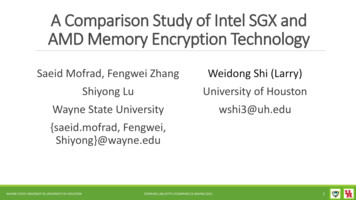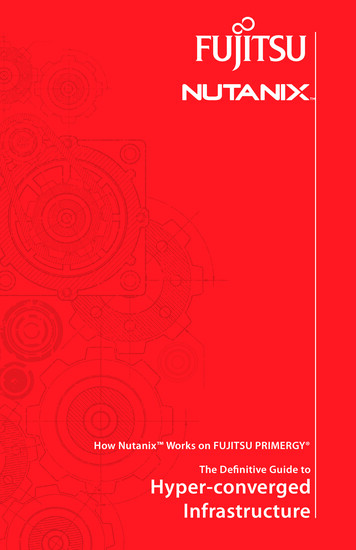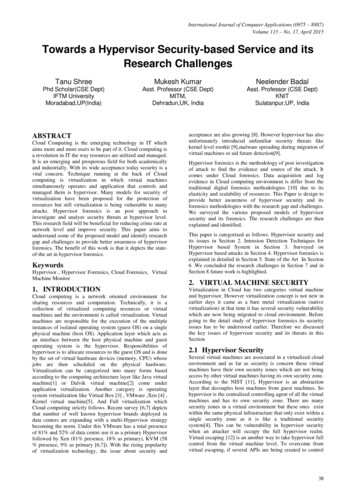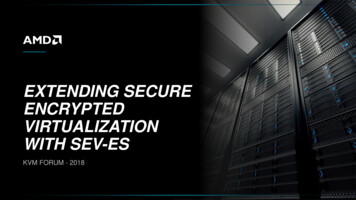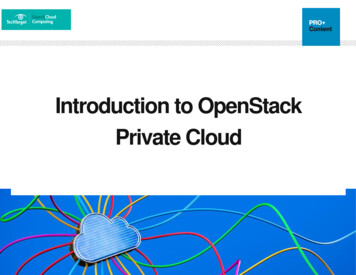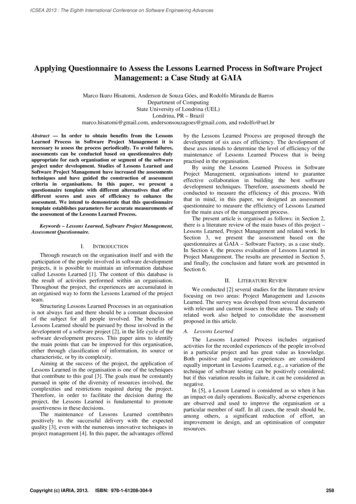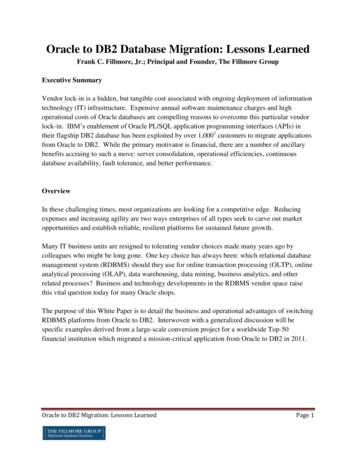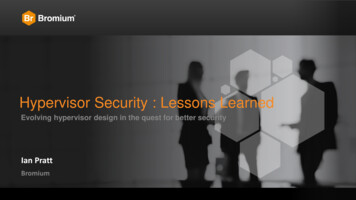
Transcription
Hypervisor Security : Lessons LearnedEvolving hypervisor design in the quest for better securityIan PrattBromium
Hypervisor Genealogy 2001 Xen / XenServer 2008 XenClient / OpenXT 2011 hXen / µXen / Type-1.5 2016 AX Bromium 20182
Xen and the Art of Virtualization Developed to support XenoServers project Run arbitrary apps for fee on shared infrastructure – VMs enable containerization Requirements Robust spatial and temporal isolation of VMs Design Avoid complex and slow binary emulation or translation (no VT-x/AMDV)Port kernel to a paravirtual API supported by hypervisor (Linux, XP/2003, *BSD) Use x86 segmentation to protect hypervisor from guest Problem when x64 appeared without segment limits in 2003/4 Necessary to use pagetable switching, tricks to preserve TLB entries Bromium 20183
Xen and Virtualization Extensions VT-x / AMDV arrived in 2005/6, Xen was ready with support VM entry/exit initially very slow, started getting quite good in 2008 Avoid enter/exit roundtrips by looking ahead in instruction stream Scary complex x86 emulation Shadow pagetables required to handle composite memory translation until EPT/NPT in 2008 Required considerably complexity to make perform wellPerformed better than EPT/NPT until 2009 By 2009 it was clear that using virtualization extensions was just better in every way, especiallyin reducing hypervisor complexity and hence improving security Having a large deployed base of legacy VMs on legacy hardware makes it hard to move forward 10 years later still not dead Bromium 20184
XenClient Opportunity to create a showcase for how Xen should be configured for security Guest VMs use VT-x/AMDV Dissagregation Qemu stub domainsRestartable driver domains e.g. for network/WiFi ; USB StorageService VMs e.g. VPN VMs Mandatory Access Control : SELinux dom0, XSM Required PCI passthrough for driver domains, GPU etc using VT-d/IOMMU Worrying complexity; Need to really understand device BARs, config space etc DRoT with TXT, enable attestation, use sealed storage for encryption keys Challenges making TXT work on vendor platforms, very limited STM BIOS availability Bromium 20185
Bromium vSentry Requirements Create a VM for every user-centric task Every web page, every document, every email etcSupport many concurrent VMs on laptop/desktop hardware VM cloning, Copy-on-Write memory Transparent to the end user Create clone VMs in tens of millisecondsGreat interactive performance, battery lifeSupport multi touch screens and trackpads etc Cross platform: Windows, MacOS, Linux/Android Must provide very robust spatial isolation Introspection into VMs for forensic purposes Bromium 20186
Bromium 20187
µXen Package hypervisor as a platform independent module that can be loaded by Host kernel Set of in/out interfaces linked at module load time Host thread calls in to uXen module to run VCPU Return when need IO assistance, or when pre-emption possibleCall out from module to host kernel for memory allocation, cross-CPU synchronization Use host OS scheduler Bromium 20188
µXen Architecture Require VT-x/AMDV, EPT/NPT No legacy hardware supportNo legacy guest support (guest automatically recreated) PV device interfaces all built on simple hypervisor copy-based primitive No memory sharing (grant tables); copyingNo xenstore, though still allow device reconnectionSimple, narrow interfaces Emulated devices irrevocably disabled post-boot (prior to exposure to anything untrusted) Simple Viridian synthetic devices for LAPIC, timersOnly very simple instruction decoder required Only 3 of the many potential guest escape XSA’s have ever been relevant to uXen Bromium 20189
µXen VM Monitoring Collect threat intelligence by monitoring guest execution Black box flight recorder trace of execution, held in host to prevent tamper by guestIntrospection of key data structures, network, storage; plus guest instrumentation Since application is known, look for divergence from expected behavior State machine generates trigger when something interesting happensMost users just allow execution to continue and collect full kill chain Nothing to steal; no way to move laterally; no way to persist Attacker thinks they have succeededPreserve flight recorder trace, and stream to collection server for analysis Bromium 201810
µXen Experience Installed on a lot of systems, HP Sure Click Billions of VMs created Internal and external review Code auditing Grey box pen testing Bug bounties Fuzzing, fault injection on hypervisor entry path Exploit mitigation techniques e.g. separate heap for any user-controlled data Never memory map more than you need Use all the help from the compiler and tools you can get Bromium 201811
uXen “Type-1.5” Extensions Design goal: Allow some VMs that are more trusted than the host, Protected VMs (pVMs) Protected from the host from a Confidentiality and Integrity point of viewUse pVMs for running high-value applications and their OS Not just small sensitive parts of applications as per SGX Runtime de-privileging of the running host into a VM Establish DRoT with TXTCreate Host VMCS and EPT/VT-d tables to allow access to all resources except those used byhypervisor module and pVMspVMs use host for IO, should ensure encrypted and authenticated (VPN, dm-verity etc)Measure and attest to initial state of each pVM Able to kill pVMs, scrub memory, re-privilege the host Bromium 201813
Bromium 2014Host CPU De-privilegeVMCS #0ring3ring3Host OSHost g0uxen.sysuxen coreRootVirtualroot-ring0uxen coreHardware Bromium 201814
Execution ModelVMCS #0ring3userVM0 HostOSVM2uxendm.exeVM1uxendm.exehVMCS #1VMCS alRoot Bromium 2018VMCALLring06Return5VMEXIT43VMENTERuxen core15
AX Design Goals Build on ideas from uXen-T1.5 Protected VMs concepts important in Client and Cloud Reduce trust in Cloud Providers Run high-value applications on hosts of unknown state (e.g. BYOD) Focus on minimal TCB SRoT and DRoT Embrace nested virtualization Common in Cloud; Client Hyper-v Bromium 201816
AX Architecture UEFI module, de-privilege running system ahead of host OSCan load from system disk or package as DXE/PEI firmware module Minimal TCB, just a few KLOC of guest-facing code Implement minimum for spatial isolation of resources, Confidentiality and Integrity Scheduling is outside TCB – can use trusted RTOS / SE Linux if you care Hierarchical subdivision of resources Enforce resource Subset rules, Enforce Exclusion rules for Protected VMs Enables arbitrary nesting of VMs, even if nested hypervisors don’t support nesting Enables uXen to run on top of Win10 hyper-v even though hyper-v doesn’t supportnesting System performance excellent on modern hardware Bromium 201817
18Win10 VBS virtualization stack with AXL1 VML2 VML2 VML3 VML3 VMWin uVML3 VMWin uVMpVMWin10 Host running uXenVBS VMHyper-vL0 Bare metal Bromium 2018AX18
AX Isolation Enforcement AX ensures nested VMs are contained and can not exceed the resources of their parent VMs orimpact their privacy or integrity Thus VBS CG/DG isolation design goals are maintained Enhanced through additional introspection of hyper-v When Protected VMs are created, enforcement of spatial protection is made symmetric Confidentiality and integrity of the child VM is ensured from the parent as well as vice versaEnsure EPT/VT-d memory regions of VMs are disjoint Remove pages referenced in child VM’s EPT from all parent VMs’ EPT When child VM terminates scrub and return pages Use AMD Secure Encrypted Virtualization (SEV-ES) features for additional protectionKeep child VM register state and VMCS/VMCB state in AX, parent VM sees and manipulatesshadow state only Bromium 20181919
Protected VM IO/MMIO/DMA operations Outer hypervisor can not see pVM’s registers or memory state Hence traditional instruction emulation or virtual DMA not possibleUse proven uXen communication primitive, guest drivers and backends Use specially configured Linux kernel to use PV drivers, LAPIC, timers For Windows use reflective injection of IO/MMIO events back into an instructionemulator running in the context of the pVM that will then use the existing PV interface Allows register and memory access since in context of pVM De-privileges complex emulation code keeping AX small and simple Fits with AMD SEV-ES Bromium 20182020
Protected VM Input/Output paths Confidentiality and integrity provided within pVM, but data passes through host/driversNet : Use TLS/IPSec connections terminated in pVM Block : Use Authenticated Encryption / Merkle hash trees for integrity Take ownership of device in a Service VM, virtualize to other VMs Keyboard : Route input to the currently focussed pVM thus preventing snooping or injection Easier with laptop keyboards (PS2), harder with USB – use “shadow URBs” to parse trafficand extract HID events Enables restartable driver domain model as per XenClient Secure video path immune to screen scraping or injection remains challenging if host OS isallowed to use GPU Not all use cases require secure video path Use s/w rendering; GPU stealing; or separate GPUs Ongoing work with h/w vendors to support safe sharing or secure overlays Bromium 20182121
Measurement and Attestation Populate memory image of S3 suspended VM (no device or CPU state), measure on launch Only launch PKI signed pVMs with a certificate chain that can be validated against a list of CAcerts to prevent abuse Allow pVM to get TPM quotes of boot state and VM launch state, attest to 3rd parties Use vTPM or moderated pass-through of hardware TPM Currently, destroy protected VMs on host S3/S4 sleep Future option to allow save/restore of VMs using authenticated encryption Bromium 20182222
AX Experience Easy to get broad platform support for a client hypervisorTested on all HP Systems Exploit mitigation techniques have proved useful AX contains no indirect branches – proved helpful with Spectre Absolute branches due to CFG; Extreme ASLR Introspection capabilities have proved very helpfulMonitoring integrity of Hyper-v, Windows Scales well to very large systems, down to small IoT systems Very useful security properties for IoT, Client and Cloud Architecture has a huge influence on Security. Keep it Simple and Small. Bromium 201823
By 2009 it was clear that using virtualization extensions was just better in every way, especially in reducing hypervisor complexity and hence improving security Having a large deployed base of legacy VMs on legacy hardware makes it hard to move forward 10 years later still not dead Xen and Virtualization Extensions



